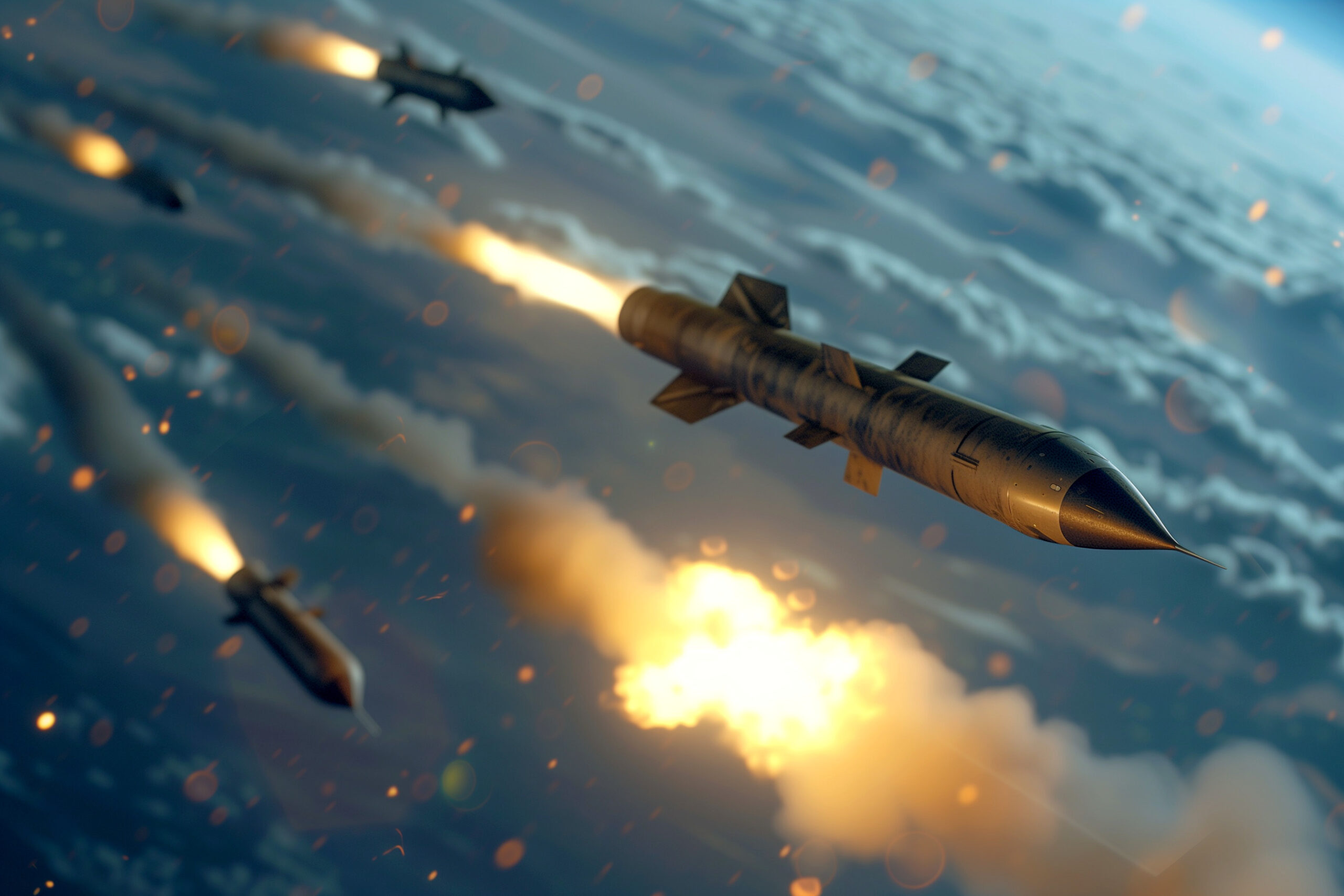Updated 28. January 2025 by Sören Spieckermann
Damage dice in Battletech Alpha Strike

Battletech Alpha Strike has a much simplified set of rules for combat compared to the Classic variant. Possible hits and the resulting damage(damage dice) naturally have a major influence on the course of the game. This is therefore a very central component of the rules. Early on, players experimented with alternative methods for these hit rolls. Currently, three further variants have been developed and are used by a wide variety of players. Before each game, you should therefore agree with your fellow players which rule you will use. In tournaments or public rounds, this is usually specified in advance in the invitation/description or the “house rules”.
I would like to introduce you to the standard variant and the three most common alternatives and also show you the respective advantages and disadvantages of the individual variants and what practical effects they have. In addition, I would like to give you an indication of the considerations behind each variant. “Could” because I am not the inventor of the respective method and can therefore only explain from my point of view which considerations could have led to this variant.
We will take the following initial situation as an example for all the variants presented here.
A Warhammer 6D shoots at an Archer 2S. Distance is 12 inches (medium distance). There is no obstacle (e.g. forest) between the battlemechs and both battlemechs are running normally.
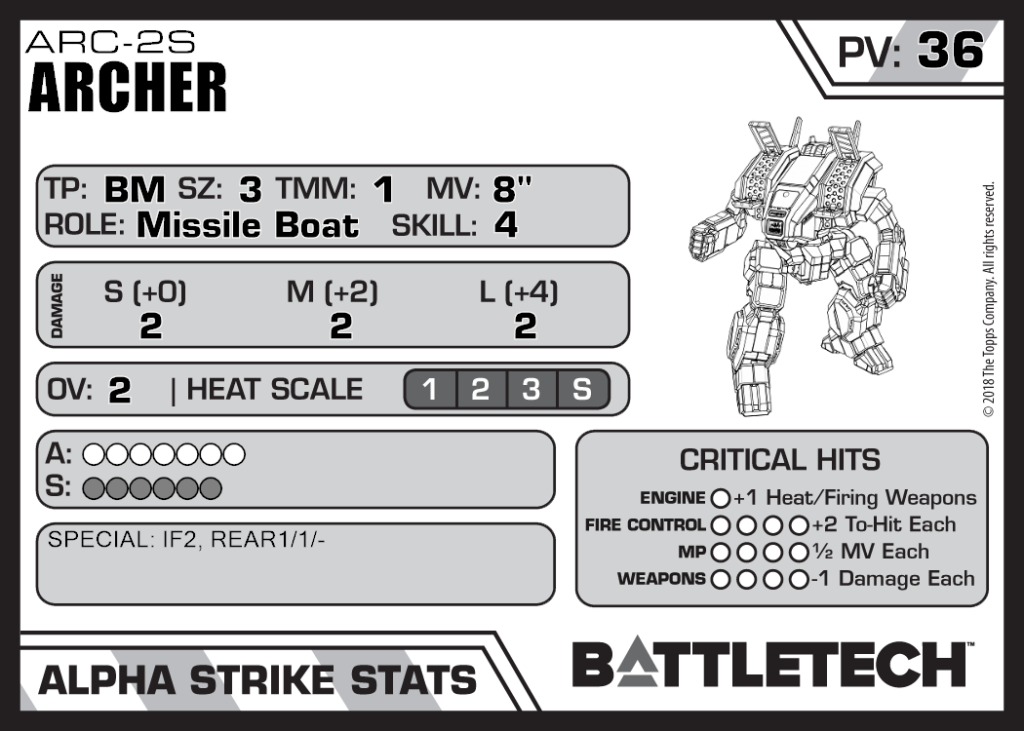
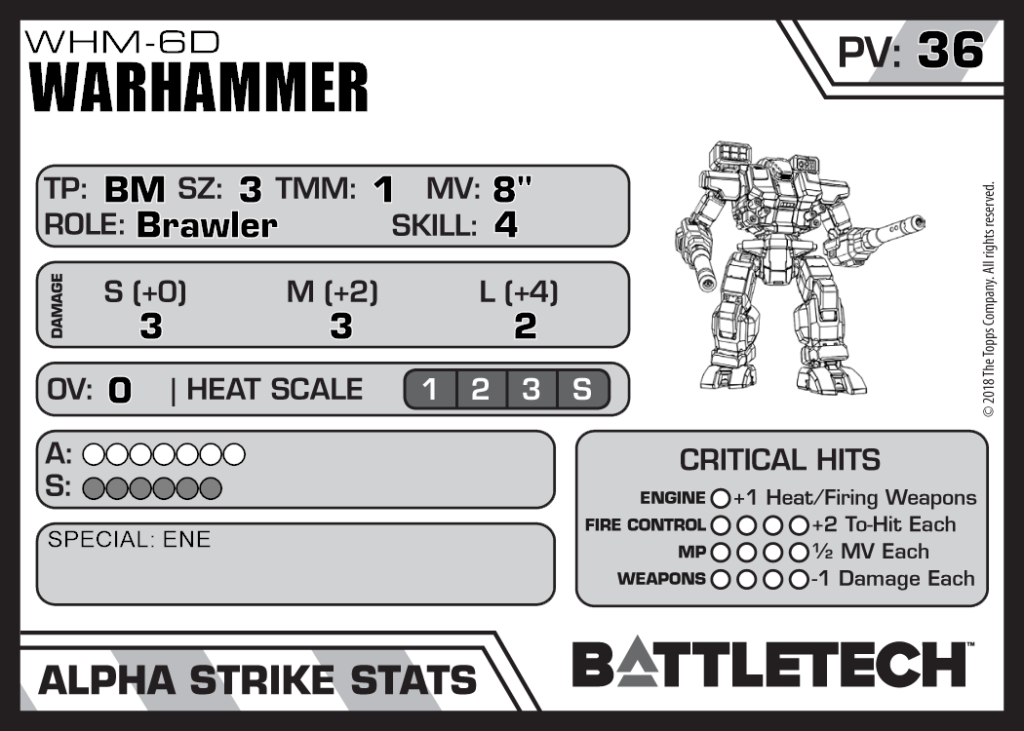
Which dice value is necessary for a hit can then be determined using the well-known S.A.T.O.R. method: (Rulebook Commanders Edition Version 7 on page 40)
- SkillRating of the attacker
- AttackerMovement Modifier
- TargetMovement Modifier
- Othermodifiers (typically terrain, partial cover, heat)
- RangeModifiers
In our example, this would be
- SkillRating of the attacker = +4
- AttackerMovement Modifier = normal movement = +0
- TargetMovement Modifier: =TMM = +1
- Othermodifiers (typically terrain, partial cover, heat) = +0
- RangeModifiers = Medium Range = +2
Result: In this example, to hit with 2W6 you need a value greater than or equal to 7 (4+0+1+0+2)
Determining the required dice value(damage dice) for a hit is identical for all dice variants presented here.
Standard variant
In the standard variant, the required dice value of the damage dice for a hit is determined first. In our example, this is 7. The Warhammer generates 3 points of damage at medium range.
If you now roll 2W6 and have at least a 7, the Warhammer hits the Archer. In this standard variant, it then deals all the damage for the distance. In our case, 3 points of damage. This means that three points of armor would now be “deducted” from the Archer.
Special case: If the attack roll is successful, it causes at least one point of damage and if the roll is a 12 (two 6s), the attack is automatically a critical hit (see Inflicting damage, p. 49 in the rulebook). Even if no internal structure has been damaged, a critical damage roll is made on a 12.
Theoretical background to this variant
Alpha Strike is also a term for an attack where you use everything available at the same time. In this simple standard rule for damage dice, it is assumed that all weapons of the battlemech are used simultaneously for this range. And if one of them hits, all the others hit as well.
MULTIPLE ATTACK ROLLS (MAR) variant for damage cubes
This variant is described in the Commanders Edition on page 174)
In contrast to the standard variant, the dice are rolled separately for each possible point of damage. In our case, 3 times, as the Warhammer can generate three points of damage at medium range. We have already determined the necessary dice result for a hit, so this does not change. It remains at 7.
The player attacking with the Warhammer now rolls the dice 3 times (or uses 3 different colored pairs of dice and rolls them once). He has the following results: A 5, an 8 and a 6.
Since only the 8 is greater than/equal to the required 7, only one of the three shots hits. The Archer therefore only suffers one point of damage.
Theoretical background to this variant
Here you can imagine that each damage point is a weapon/shot. A battlemech normally has several weapons, and this variant takes this into account. The simplified assumption is that each possible point of damage is a shot from a weapon. Therefore, each shot is rolled separately and independently.
MULTIPLE DAMAGE ROLLS (MDR) variant for damage cubes
Roughly speaking, the MDR variant is a mix of the standard variant and the MAR. You roll 2 dice as in the standard variant to determine whether you have hit or not. But then you also roll 1D6 for each possible point of damage (in our case, 3 at medium range). If the result of the 1D6 roll (the so-called “damage rolls”) is 3 or higher, the damage is generated. However, at least 1 point of damage is always generated if you hit with the 2W6, even if all damage rolls were less than 3.
Example:
Remember, the player must roll at least a 7 to hit, and the Warhammer deals 3 points of damage at medium range. He now rolls 2W6 to determine whether he hits at all or not. He rolls a 9, so he has hit. Now he rolls 3 x 1D6. He has a 2, a 4 and a 5, i.e. only two of the three damage roll dice had at least a 3, and therefore only two (of 3 possible) damage points are generated.
Another example: The player rolls a 9 with 2W6, i.e. he has hit. On the three 1W6 damage rolls, he has a 1, another 1 and finally a 3. This means that only one damage roll was greater than/equal to the value 3 and therefore only one point of damage is generated.
Theoretical background to this variant
Here, too, you can imagine that each point of damage is a weapon/shot (as with the MAR variant). However, here the point “do I hit at all” and “with which shot do I hit” are rolled separately. For example, you can imagine that the 2W6 roll (whether I hit at all) reflects the pilot’s care and skill when aiming in this specific situation. The subsequent “damage rolls” then reflect the “peculiarities” of hitting the respective weapon/shot.
The DFA variant for damage cubes
This variant is named after DFA Wargaming . Unfortunately, it is no longer possible to determine whether they also invented this variant. The variant is described in their “House rules” under “Pilot die”. This variant uses a “pilot die” (1D6, must be clearly different from the other dice used) and a further die (1D6) for each possible point of damage. The single pilot die is then added to each of the individual damage dice to determine a hit or miss.
In our example, you need a 7 to hit, and the Warhammer generates 3 points of damage at medium range. So you roll the pilot die and three other D6 dice. (a total of four six-sided dice).
Let’s take an example: The pilot die shows a 4. The three damage dice show a 2, a 4 and a 6. This results in the following combinations: 4+2 (=6), 4+4 (=8) and 4+6 (=10) (each pilot die plus one of the damage dice). Two of the three combinations are 7 or higher. Therefore, the attack has generated two points of damage.
Theoretical background to this variant
Here, too, you can imagine that each point of damage is a weapon/shot (as with the MAR variant). Whether you hit depends on the care/skill of the pilot (pilot dice) in combination with the weapon characteristics (the additional dice per damage point).
You can find a good video about the dice methods for determining damage mentioned here in the Battletech Channel. Link: https://youtu.be/MNe-TyLLcNE?si=ktWxyRdbI_wiRkni
Damage cubes and statistics (probabilities)
What can be recognized relatively quickly are the time consequences of each variant. With the standard variant where I only have to roll the dice once, the (time) expenditure is the lowest. Quick and easy. The other variants look very similar in terms of effort. But what other influence do the variants have? Especially on the questions “With which variant am I more likely to hit?” or “With which variant less often?”. Because the more often you hit, the shorter the game rounds tend to be as Battlemechs are destroyed more quickly. And this is where the probability calculation helps. I don’t want to go into the basics here. There are plenty of examples on the net. For example, this is explained quite well here . Furthermore, I assume that the dice are not manipulated and that you have a 1/6 chance of rolling a certain number with a six-sided dice(Laplace dice).
I would like to use the probability calculation to show you the differences between the three variants. To do this, I will calculate the probabilities for two events for each variant. Once for the event “At least one point of damage generated” and “Maximum damage generated”. Again, our Warhammer shooting at the Archer serves as an example. This means that we need at least a 7 to hit and can generate a maximum of 3 points of damage.
Standard variant and its hit probabilities
“At least one point of damage generated” = 58.33% probability
Probability for “maximum damage generated” = 58.33% probability
Conclusion: The probability of hitting is 58.33% in our example. Since this variant always generates all of the damage with one hit, the probability of generating the maximum number (3) of damage is also 58%.
For the sake of completeness, here is a table for orientation. This table is very useful if you play according to this variant. It allows you to estimate which attack has the highest chance of success if you have several targets to choose from.

MULTIPLE ATTACK ROLLS (MAR) variant and their hit probabilities
“At least one point of damage generated” = 92.77% probability
Probability for “maximum damage generated” = 19.84% probability
Conclusion: The probability of hitting (at least one point of damage) is 92.77% in our example. This is also plausible, as I have three chances to roll at least a 7 with two dice. The probability of “at least 1 point of damage” must therefore be higher than in the standard variant where I only have one chance to roll a 7 or higher.
However, to get the total amount of damage, I have to roll at least a 7 three times in a row. The probability here is only around 20%. This value is below the 58% of the standard variant. Which is also logical. Because I don’t just have to roll at least a 7 once here, but three times. Which is less likely.
Conclusion: With this variant, the probability of hitting at all tends to increase. However, the probability of generating “a lot” of damage per hit decreases. In other words, the probability is distributed in such a way that you cause more damage, but less damage than with the standard variant.
MULTIPLE DAMAGE ROLLS (MDR) – Variant and their hit probabilities
“At least one point of damage generated” = approx. 58% (But only because a hit also generates at least one point of damage. Without this rule, the probability would be approx. 39%)
Probability for “maximum damage generated” = approx. 17% probability
Conclusion: It is quite likely that you will generate at least one point of damage. (the same as with the standard variant). However, generating the maximum damage of three damage points is even less likely than with the MAR method.
DFA variant and its hit probabilities
Unfortunately, I have to admit that my knowledge of statistics is letting me down here. I have calculated figures, but I don’t know whether they are correct. So I’d better not write that here. However, it can be said about the method that a special observation can be made from practice. Either you hit and then cause relatively high damage. Or you don’t hit at all or only with very little damage. This method therefore tends to encourage “extremes”.
You can also see this in our example where you have to roll a 7 to hit. If you get a 6 with the pilot die, it doesn’t matter what you get with the other dice. You always get a 7 in total. (You can’t roll less than 1). You have therefore dealt the maximum damage. If, on the other hand, you roll a 1 with the pilot die, you need a 6 on the other dice to hit. In this case, you hit very little.
Advantages and disadvantages of the damage cube methods
Standard variant
Advantages
- Easy to learn
- Fast processing (little time required)
- Relatively high probability of generating the maximum possible damage or hitting it at all
- Suitable for battles with a large number of units (e.g. company vs. company or more) due to the short time required and the relatively quick destruction of targets.
Disadvantages
- In games in later eras of Battlemech, the effectiveness of the weapon systems has increased significantly (e.g. comparison of clan weapons to Inner Sphere weapons before). This means that the damage a mech can cause at a distance is quite high. Just a few hits are enough to destroy battlemechs. For example, the clan mech Mad Cat Prime has a damage of 5 at short and medium range, while the Inner Sphere light mech Jenner JR7-D has only two armor and three structure points. A single hit from the Mad Cat is enough to completely destroy a “new” Jenner.
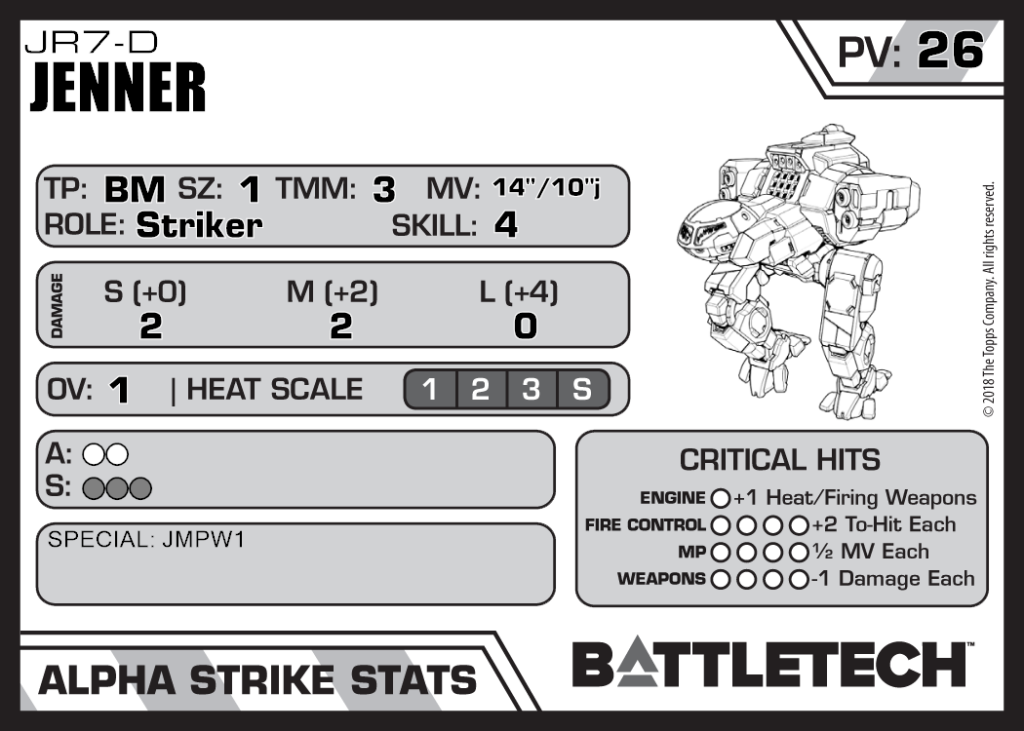
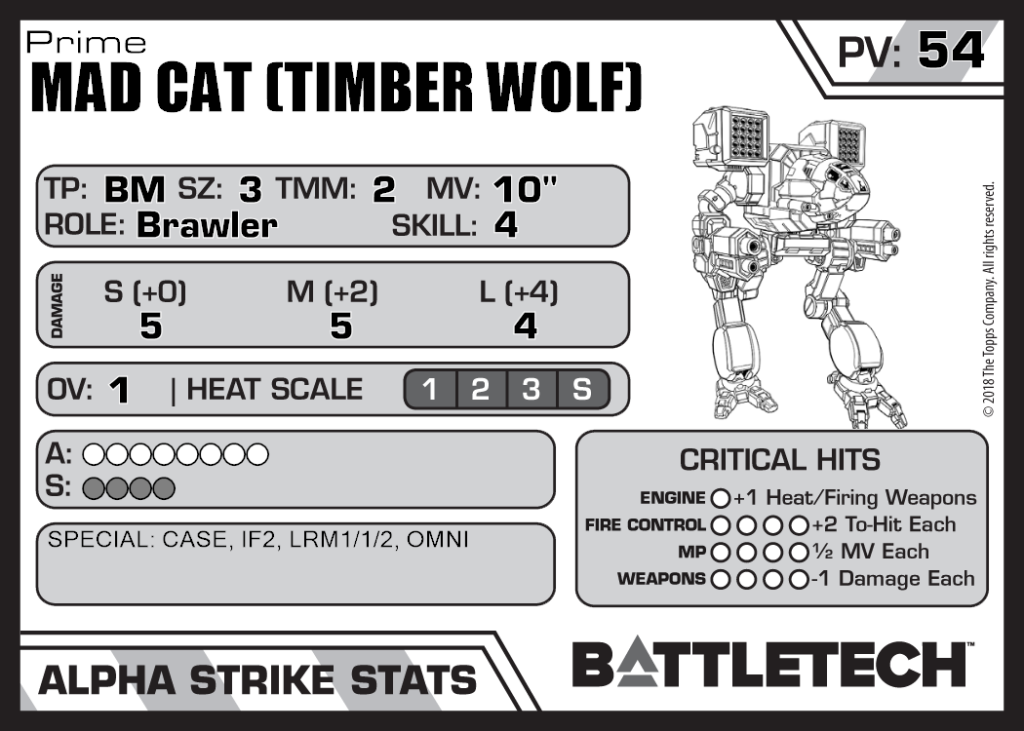
Conclusion:
This simple rule is suitable for getting started with Alpha Strike and for large-scale battles. Quick and easy. On the other hand, a hit always deals the maximum damage. This leads to faster failures of the enemy units. Even heavy or Aussault mechs can be knocked out by just a few hits from equally strong enemy mechs.
MULTIPLE ATTACK ROLLS (MAR)
Advantages
- Easy to learn / Clear rules
- Very high probability of generating damage at all (compared to the other variants)
Disadvantages
- Lower probability of generating the maximum possible damage
- Increased time requirement compared to the standard variant
Conclusion:
This simple rule is suitable for getting started with Alpha Strike and for small and medium-sized battles (up to approx. company vs. company). Battles generally take longer as the probability of hitting is one of the highest, but only an average amount of damage is generated. The “survival probability” of units increases. Although this makes the game more interesting (because you experience success in the form of hits more often), it also makes it much longer (in terms of time).
MULTIPLE DAMAGE ROLLS (MDR)
Advantages
- Relatively high probability of causing any damage at all
Disadvantages
- Most complex rule for rolling damage. However, still far from being complicated. But complex compared to the other variants.
- Increased time requirement compared to the standard variant
- Low probability of generating the maximum possible damage
Conclusion:
This rule is suitable for small and medium-sized battles (up to approx. company vs. company). Battles generally last longer as the probability of being hit is relatively high, but the damage dealt is always below average. The “survival probability” of units is one of the highest here. Although this makes the game more interesting (because you often experience success in the form of hits), it also makes it much longer (in terms of time). In my experience, this variant requires the most time, but offers no clear advantages over the other variants. In my opinion, however, it is one of the two methods that represent the fights quite realistically.
DFA – Variant
Advantages
- Simple rule
- Little time required
Disadvantages
- Low probability of generating the maximum possible damage
- method tends to be “all or nothing”. A lot depends on the result of the pilot dice.
Conclusion:
This rule is suitable for small and medium-sized battles (up to approx. company vs. company). Battles usually do not last much longer than with the standard or MDR variant. Very strong influence/dependence of the pilot dice on the overall result of an attack. Similar (“all or nothing”) behavior as with the standard variant.
In my opinion, however, this is one of the two methods that depict the fights quite realistically.


